Inorganic Chemistry/Chemical Bonding/Orbital hybridization
< Inorganic Chemistry < Chemical Bonding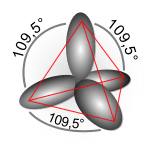
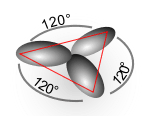
In chemistry, hybridisation (or hybridization) is the concept of mixing atomic orbitals into new hybrid orbitals suitable for the pairing of electrons to form chemical bonds in valence bond theory. Hybrid orbitals are very useful in the explanation of molecular geometry and atomic bonding properties.[1]
History
Chemist Linus Pauling first developed hybridisation theory[2] in order to explain the structure of molecules such as methane (CH4). Pauling pointed out that a carbon atom forms four bonds by using one s and three p orbitals, so that "it might be inferred" that a carbon atom would form three bonds at right angles (using p orbitals) and a fourth weaker bond using the s orbital in some arbitrary direction. In reality however, methane has four bonds of equivalent strength separated by the tetrahedral bond angle of 109.5°. Pauling explained this by supposing that in the presence of four hydrogen atoms, the s and p orbitals form four equivalent combinations or hybrid orbitals, each denoted by sp3 to indicate its composition, which are directed along the four C-H bonds.[3] Historically, this concept was developed for such simple chemical systems but the approach was later applied more widely, and today it is considered an effective heuristic for rationalizing the structures of organic compounds. It gives a simple orbital picture equivalent to Lewis structures. Hybridisation theory finds its use mainly in organic chemistry.
Atomic orbitals
Orbitals are a model representation of the behavior of electrons within molecules. In the case of simple hybridisation, this approximation is based on atomic orbitals, similar to those obtained for the hydrogen atom, the only atom for which an exact analytic solution to its Schrödinger equation is known. In heavier atoms, like carbon, nitrogen, and oxygen, the atomic orbitals used are the 2s and 2p orbitals, similar to excited state orbitals for hydrogen.
Overview
Hybrid orbitals are assumed to be mixtures of atomic orbitals, superimposed on each other in various proportions. For example, in methane, the C hybrid orbital which forms each C-H bond consists of 25% s character and 75% p character and is thus described as sp3 (read as s-p-three) hybridised. Quantum mechanics describes this hybrid as an sp3 wavefunction of the form N[s + (√3)pσ], where N is a normalization constant (here 1/2) and pσ is a p orbital directed along the C-H axis to form a sigma bond. The p-to-s ratio (denoted λ in general) is √3 in this example, and N2λ2 = 3/4 is the p character or the weight of the p component.
In general, any two hybrid orbitals on the same atom must be mutually orthogonal. For an atom with s and p orbitals forming hybrids hi and hj with included angle , the orthogonality condition implies the relation: 1 + ij cos() = 0. The p-to-s ratio for hybrid i is i2, and for hybrid j it is j2. The bond directed towards a more electronegative substituent tends to have higher p-character as stated in Bent's rule. In the special case of equivalent hybrids on the same atom, again with included angle , the equation reduces to just 1 + 2 cos() = 0. For example, BH3 has a trigonal planar geometry, three 120° bond angles, three equivalent hybrids about the boron atom, and thus 1 + 2 cos() = 0 becomes 1 + 2 cos(120°) = 0, giving 2 = 2 for the p-to-s ratio. In other words, sp2 hybrids.
Hybridisation schemes can also be used to represent the electron configuration in transition metals. For example, the permanganate ion (MnO4-) has sd3 hybridisation with orbitals that are 25% s and 75% d.
Types of hybridisation
sp3
For a tetrahedrally coordinated carbon (e.g., methane CH4), the carbon should have 4 orbitals with the correct symmetry to bond to the 4 hydrogen atoms.
Carbon's ground state configuration is 1s2 2s2 2p2 or more easily read:
| C | ↑↓ | ↑↓ | ↑ | ↑ | |
| 1s | 2s | 2p | 2p | 2p |
(Note: The 1s orbital is lower in energy than the 2s orbital, and the 2s orbital is lower in energy than the 2p orbitals)
The carbon atom can utilize its two singly occupied p-type orbitals, to form two covalent bonds with two hydrogen atoms, yielding the singlet methylene CH2, the simplest of the carbenes. The carbon atom can also bond to four hydrogen atoms by an excitation of an electron from the doubly occupied 2s orbital to the empty 2p orbital, so that there are four singly occupied orbitals.
| C* | ↑↓ | ↑ | ↑ | ↑ | ↑ |
| 1s | 2s | 2p | 2p | 2p |
As the additional bond energy more than compensates for the excitation, the formation of four C-H bonds is energetically favoured.
Quantum mechanically, the lowest energy is obtained if the four bonds are equivalent, which requires that they be formed from equivalent orbitals on the carbon. A set of four equivalent orbitals can be obtained that are linear combinations of the valence-shell (core orbitals are almost never involved in bonding) s and p wave functions,[4] which are the four sp3 hybrids.
| C* | ↑↓ | ↑ | ↑ | ↑ | ↑ |
| 1s | sp3 | sp3 | sp3 | sp3 |
In CH4, four sp3 hybrid orbitals are overlapped by hydrogen's 1s orbital, yielding four σ (sigma) bonds (that is, four single covalent bonds) of the same length and strength.
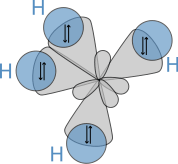 translates into
translates into 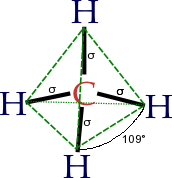
sp2
Other carbon based compounds and other molecules may be explained in a similar way as methane. For example, ethene (C2H4) has a double bond between the carbons. The Lewis structure looks like this:
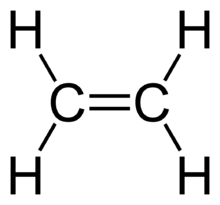
For this molecule, carbon sp2 hybridises, because one π (pi) bond is required for the double bond between the carbons and only three σ bonds are formed per carbon atom. In sp2 hybridisation the 2s orbital is mixed with only two of the three available 2p orbitals:
| C* | ↑↓ | ↑ | ↑ | ↑ | ↑ |
| 1s | sp2 | sp2 | sp2 | 2p |
forming a total of three sp2 orbitals and one remaining p orbital. In ethylene the two carbon atoms form a σ bond by overlapping two sp2 orbitals and each carbon atom forms two covalent bonds with hydrogen by s–sp2 overlap all with 120° angles. The π bond between the carbon atoms perpendicular to the molecular plane is formed by 2p–2p overlap. The hydrogen-carbon bonds are all of equal strength and length, which agrees with experimental data.
sp
The chemical bonding in compounds such as alkynes with triple bonds is explained by sp hybridization. In this model, the 2s orbital mixes with only one of the three p-orbitals,
| C* | ↑↓ | ↑ | ↑ | ↑ | ↑ |
| 1s | sp | sp | 2p | 2p |
resulting in two sp orbitals and two remaining p orbitals. The chemical bonding in acetylene (C2H2) consists of sp–sp overlap between the two carbon atoms forming a σ bond and two additional π bonds formed by p–p overlap. Each carbon also bonds to hydrogen in a sigma s–sp overlap at 180° angles.
Hybridisation and molecule shape
Hybridisation helps to explain molecule shape:
| Classification | Main group | Transition metal[5][6] |
|---|---|---|
| AX2 |
|
|
| AX3 |
|
|
| AX4 |
|
|
| AX5 |
| |
| AX6 |
|
Hybridisation of hypervalent molecules
Valence shell expansion
In general chemistry courses and mainstream textbooks, hybridisation is often presented for main group AX5 and above, as well as for transition metal complexes, using the hybridisation scheme first proposed by Pauling.
| Classification | Main group | Transition metal |
|---|---|---|
| AX2 |
| |
| AX3 |
| |
| AX4 |
| |
| ||
| AX5 |
|
Trigonal bipyramidal or Square pyramidal[7] |
| AX6 |
|
|
| AX7 |
|
Pentagonal bipyramidal, Capped octahedral or Capped trigonal prismatic[8][6] |
Contrary evidence
In 1990, Magnusson published a seminal work definitively excluding the role of d-orbital hybridization in bonding in hypervalent compounds of second-row elements. This had long been a point of contention and confusion in describing these molecules using molecular orbital theory. Part of the confusion here originates from the fact that one must include d-functions in the basis sets used to describe these compounds (or else unreasonably high energies and distorted geometries result), and the contribution of the d-function to the molecular wavefunction is large. These facts were historically interpreted to mean that d-orbitals must be involved in bonding. However, Magnusson concludes in his work that d-orbital involvement is not implicated in hypervalency.[9][10]
For transition metal centers, the d and s orbitals are the primary valence orbitals, which are only weakly supplemented by the p orbitals.[11] The question of whether the p orbitals actually participate in bonding has not been definitively resolved, but all studies indicate they play a minor role.
Resonance
In light of computational chemistry, a better treatment would be to invoke sigma resonance in addition to hybridisation, which implies that each resonance structure has its own hybridisation scheme. For main group compounds, all resonance structures must obey the octet (8) rule. For transition metal compounds, the resonance structures that obey the duodectet (12) rule[12] suffice to describe bonding, with optional inclusion of dmspn resonance structures.
| Classification | Main group | Transition metal |
|---|---|---|
| AX2 | Linear (180°) | |
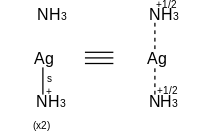 | ||
| AX3 | Trigonal planar (120°) | |
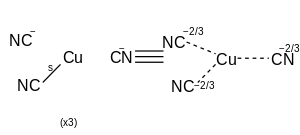 | ||
| AX4 | Tetrahedral (109.5°) | |
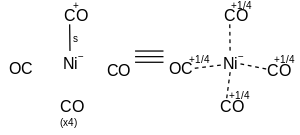 | ||
| Square planar (90°) | ||
 | ||
| AX5 | Trigonal bipyramidal (90°, 120°) | Trigonal bipyramidal or Square pyramidal[7] |
 | ||
| AX6 | Octahedral (90°) | Octahedral (90°) |
 |
 | |
| AX7 | Pentagonal bipyramidal (90°, 72°) | Pentagonal bipyramidal, Capped octahedral or Capped trigonal prismatic[8][6] |
 |
Isovalent hybridisation
Although ideal hybrid orbitals can be useful, in reality most bonds require orbitals of intermediate character, analogous to intermediate ionic-covalent character. This requires an extension to include flexible weightings of atomic orbitals of each type (s, p, d) and allows for a quantitative depiction of bond formation when the molecular geometry deviates from ideal bond angles. The amount of p-character is not restricted to integer values; i.e., hybridisations like sp2.5 are also readily described.
The hybridisation of bond orbitals is determined by Bent's rule: "Atomic s character concentrates in orbitals directed toward electropositive substituents".
Molecules with lone pairs
For molecules with lone pairs, the bonding orbitals are hybrids with intermediate s and p character. For example, the two bond-forming hybrid orbitals of oxygen in water can be described as sp4[13] to give the interorbital angle of 104.5°. This means that they have 20% s character and 80% p character and does not imply that a hybrid orbital is formed from one s and four p orbitals on oxygen since the 2p subshell of oxygen only contains three p orbitals. The shapes of molecules with lone pairs are:
- Trigonal pyramidal
- Three isovalent bonding hybrids
- E.g., NH3
- Bent
- Two isovalent bonding hybrids
- E.g., SO2, H2O
In such cases, there are two mathematically equivalent ways of representing lone pairs. They can be represented with orbitals of sigma and pi symmetry similar to molecular orbital theory or with equivalent orbitals similar to VSEPR theory.
Hypervalent molecules
For hypervalent molecules with lone pairs, the bonding scheme can be split into a hypervalent component and a component consisting of isovalent bonding hybrids. The hypervalent component consists of resonating bonds utilizing p orbitals. The table below shows how each shape is related to the two components and their respective descriptions.
| Number of isovalent bonding hybrids (marked in red) | ||||
|---|---|---|---|---|
| Two | One | - | ||
| Hypervalent component | Linear axis (one p orbital) |
Seesaw (AX4E1) (90°, 180°, >90°) | T-shaped (AX3E2) (90°, 180°) | Linear (AX2E3) (180°) |
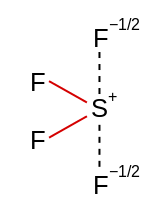 |
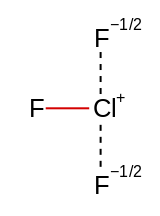 |
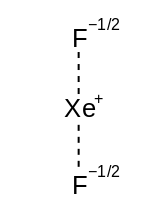 | ||
| Square planar equator (two p orbitals) |
Square pyramidal (AX5E1) (90°, 90°) | Square planar (AX4E2) (90°) | ||
 |
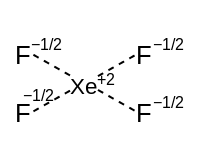 | |||
| Pentagonal planar equator (two p orbitals) |
Pentagonal pyramidal (AX6E1) (90°, 72°) | Pentagonal planar (AX5E2) (72°) | ||
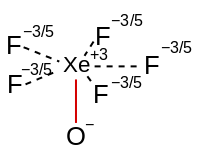 |
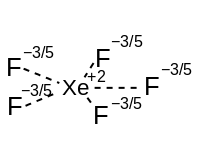 | |||
Photoelectron spectra
One misconception concerning orbital hybridisation is that it incorrectly predicts the ultraviolet photoelectron spectra of many molecules. While this is true if Koopmans' theorem is applied to localized hybrids, quantum mechanics requires that the (in this case ionized) wavefunction obey the symmetry of the molecule which implies resonance in valence bond theory. For example, in methane, the ionized states (CH4+) can be constructed out of four resonance structures attributing the ejected electron to each of the four sp3 orbitals. A linear combination of these four structures, conserving the number of structures, leads to a triply degenerate T2 state and a A1 state.[14] The difference in energy between the ionized state and the ground state would be the ionization energy, which yields two values in agreement with experiment.
Hybridisation theory vs. MO theory
Hybridisation theory is an integral part of organic chemistry and in general discussed together with molecular orbital theory in advanced organic chemistry textbooks although for different reasons. One textbook notes that for drawing reaction mechanisms sometimes a classical bonding picture is needed with 2 atoms sharing two electrons [15]. It also comments that predicting bond angles in methane with MO theory is not straightforward. Another textbook treats hybridisation theory when explaining bonding in alkenes [16] and a third [17] uses MO theory to explain bonding in hydrogen but hybridisation theory for methane.
Bonding orbitals formed from hybrid atomic orbitals may be considered as localized molecular orbitals, which can be formed from the delocalized orbitals of molecular orbital theory by an appropriate mathematical transformation. For molecules with a closed electron shell in the ground state, this transformation of the orbitals leaves the total many-electron wave function unchanged. The hybrid orbital description of the ground state is therefore equivalent to the delocalized orbital description for explaining the ground state total energy and electron density, as well as the molecular geometry which corresponds to the minimum value of the total energy.
References
- ↑ "It is important to recognize that the VSEPR model provides an approach to bonding and geometry based on the Pauli principle that is completely independent of the valence bond (VB) theory or of any orbital description of bonding." Gillespie, R. J. J. Chem. Educ. 2004, 81, 298–304.
- ↑ L. Pauling, J. Am. Chem. Soc. 53 (1931), 1367
- ↑ L. Pauling The Nature of the Chemical Bond (3rd ed., Oxford University Press 1960) p.111–120.
- ↑ McMurray, J. (1995). Chemistry Annotated Instructors Edition (4th ed.). Prentice Hall. p. 272. ISBN 0-13-140221-8
- ↑ Weinhold, Frank; Landis, Clark R. (2005). Valency and bonding: A Natural Bond Orbital Donor-Acceptor Perspective. Cambridge: Cambridge University Press. pp. 381–383. ISBN 0-521-83128-8.
- 1 2 3 Martin Kaupp Prof. Dr. (2001). ""Non-VSEPR" Structures and Bonding in d(0) Systems.". Angew Chem Int Ed Engl. 40 (1): 3534–3565. doi:10.1002/1521-3773(20011001)40:19<3534::AID-ANIE3534>3.0.CO;2-#.
- 1 2 Angelo R. Rossi, Roald. Hoffmann (1975). "Transition metal pentacoordination". Inorganic Chemistry 14 (2): 365–374. doi:10.1021/ic50144a032.
- 1 2 Roald. Hoffmann , Barbara F. Beier , Earl L. Muetterties , Angelo R. Rossi (1977). "Seven-coordination. A molecular orbital exploration of structure, stereochemistry, and reaction dynamics". Inorganic Chemistry 16 (3): 511–522. doi:10.1021/ic50169a002.
- ↑ E. Magnusson. Hypercoordinate molecules of second-row elements: d functions or d orbitals? J. Am. Chem. Soc. 1990, 112, 7940–7951. doi:10.1021/ja00178a014
- ↑ David L. Cooper , Terry P. Cunningham , Joseph Gerratt , Peter B. Karadakov , Mario Raimondi (1994). "Chemical Bonding to Hypercoordinate Second-Row Atoms: d Orbital Participation versus Democracy". Journal of the American Chemical Society 116 (10): 4414–4426. doi:10.1021/ja00089a033.
- ↑ Frenking, Gernot; Shaik, Sason, eds (May 2014). "Chapter 7: Chemical bonding in Transition Metal Compounds". The Chemical Bond: Chemical Bonding Across the Periodic Table. Wiley -VCH. ISBN 978-3-527-33315-8.
- ↑ C. R. Landis, F. Weinhold (2007). "Valence and extra-valence orbitals in main group and transition metal bonding". Journal of Computational Chemistry 28 (1): 198–203. doi:10.1002/jcc.20492.
- ↑ Frenking, Gernot; Shaik, Sason, eds (2014). "Chapter 3: The NBO View of Chemical Bonding". The Chemical Bond: Fundamental Aspects of Chemical Bonding. John Wiley & Sons. ISBN 9783527664719.
- ↑ Sason S. Shaik; Phillipe C. Hiberty (2008). A Chemist's Guide to Valence Bond Theory. New Jersey: Wiley-Interscience. ISBN 978-0-470-03735-5.
- ↑ Organic Chemistry. Jonathan Clayden, Nick Greeves, Stuart Warren, and Peter Wothers 2001 ISBN 0-19-850346-6
- ↑ Organic Chemistry, Third Edition Marye Anne Fox James K. Whitesell 2003 ISBN 978-0-7637-3586-9
- ↑ Organic Chemistry 3rd Ed. 2001 Paula Yurkanis Bruice ISBN 0-13-017858-6